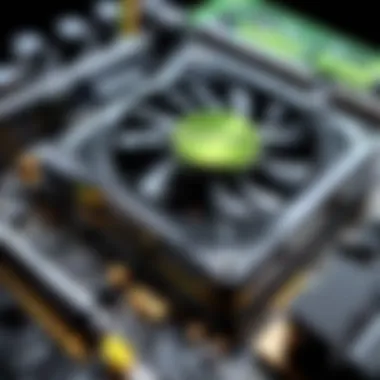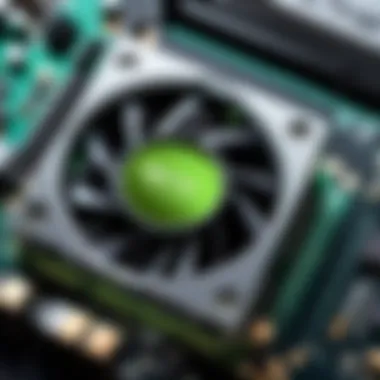In-Depth Review of the GeForce 2070 Graphics Card


Product Overview
The GeForce 2070 graphics card, a member of NVIDIA's well-known RTX series, has carved a niche for itself among gamers and content creators. Launched in 2018, this card packs a punch and boasts capabilities aimed at delivering high frame rates and stunning visual effects.
Key Features
The GeForce 2070 shines with key features, including:
- Turing Architecture: This architecture enables real-time ray tracing and AI-based features.
- DLSS Support: NVIDIA's Deep Learning Super Sampling allows for better performance in supported games without sacrificing image quality.
- 8GB GDDR6 Memory: Provides ample memory to handle modern gaming and rendering tasks efficiently.
- VR Ready: It's built with virtual reality in mind, accommodating immersive experiences without a hitch.
Technical Specifications
In terms of specifications, here’s what the GeForce 2070 has under the hood:
- CUDA Cores: 2304
- Base Clock: 1410 MHz
- Boost Clock: 1710 MHz
- Memory Interface: 256-bit
- Memory Bandwidth: 448 GB/s
Pricing Information
As of its launch, the GeForce 2070 had a suggested retail price of about $499. However, due to market fluctuations and availability issues, actual prices might differ significantly, often landing above or below the initial cost.
Performance Analysis
When it comes to performance, the GeForce 2070 does not disappoint.
Benchmark Results
In benchmarking tests, the card shines in demanding titles:
- Shadow of the Tomb Raider: Achieves around 60 fps at high settings.
- Battlefield V: Runs smoothly at approximately 70 fps with ray tracing turned on.
These benchmarks highlight the card's reliability even in graphically intensive scenarios.
Real-World Use Cases
Aside from gaming, professionals in creative fields use the GeForce 2070:
- Video Editing: Handles 4K video rendering well, providing faster processing times.
- 3D Rendering: Software like Blender performs admirably, enhancing workflow for designers.
Comparison with Competitors
Against its contemporaries, like the AMD Radeon RX 5700 XT, the GeForce 2070 often edges forward, especially in titles that utilize ray tracing, underscoring its relevance in modern gaming.
Installation and Setup
For those ready to bring this powerhouse into their system, installation is pretty straightforward.
Required Tools and Components
To successfully install the GeForce 2070, you’ll need:
- Phillips screwdriver
- Anti-static wrist strap (optional but recommended)
- PC compatible with a PCIe x16 slot
- Adequate power supply (minimum 550W recommended)
Step-by-Step Installation Guide
- Power Down and Unplug Your Computer: Safety first.
- Open the Case: Remove the side panel of your case.
- Locate PCIe Slot: Find the x16 slot and remove the bracket.
- Insert the Card: Align the card with the slot and apply even pressure until it clicks into place.
- Connect Power Cables: Attach the necessary power connectors from the PSU.
- Close the Case: Reattach the side panel and power up. Don’t forget to install drivers from the NVIDIA website!
Troubleshooting Common Issues
If you encounter problems:
- Check your power supply connections; ensure cables are secure.
- Make sure the card is properly seated in the PCIe slot.
Pros and Cons
Advantages of the Product


- Strong performance in gaming and creative tasks.
- Excellent cooling solutions with many aftermarket options.
- Reliable driver support from NVIDIA.
Disadvantages or Limitations
- Power consumption can be high under load.
- Competing products sometimes offer better performance for the price.
Who It’s Best Suited For
This card is ideally suited for gamers looking for high resolution at good frame rates and creators who need a dependable workhorse for their software.
Final Thoughts
Summary of Key Points
In essence, the GeForce 2070 stands out in terms of performance and versatility. Its strengths in ray tracing and content creation make it a solid investment.
Recommendations for Potential Buyers
Considering its capabilities, the 2070 is best for those who seek quality without diving into the higher price brackets of newer offerings.
Future of the Technology or Product Line
As technology progresses, the relevance of older models like the GeForce 2070 may start to wane. However, the introduction of driver updates and optimized games could extend its usefulness for quite some time.
Overview of the GeForce Graphics Card
When discussing high-performance graphics cards, the GeForce 2070 typically stands out as a vital player in NVIDIA's ever-expanding lineup. This card is not just a mere upgrade from its predecessors; it symbolizes a leap in performance, efficiency, and technology that caters to a diverse range of users, from hardcore gamers to creative professionals.
Prelims to GeForce Series
The GeForce series, which has molded the gaming landscape for years, showcases NVIDIA's relentless push for perfection and innovation. The lineup has grown from simple graphics enhancement to complete gaming solutions packed with AI and ray tracing capabilities. The GeForce 2070 marks a pivotal chapter in this evolution, demonstrating NVIDIA's ability to adapt to the growing demands of modern applications.
Reflecting on the introduction of this series, it’s clear that NVIDIA has harnessed the power of its architecture to tackle not just gaming, but also a variety of professional tasks. By introducing powerful features at competitive pricing, AMD and NVIDIA are in a constant dance to win the hearts of many enthusiasts, making their products noteworthy for various user preferences.
Release and Target Audience
The GeForce 2070 entered the scene in 2018, aimed squarely at those seeking high-performance without delving into the realm of the excessive high-end cards. Its reasonably priced entry point positioned it as an attractive option for gamers and creative professionals alike, catering to those passionate about visuals and performance but cautious about budget constraints.
NVIDIA recognized the needs of enthusiasts looking for best bang for their buck. By creating a card that excels in 1440p gaming and next-gen rendering techniques, they appealed to a broad audience, from casual gamers to serious streamers, as well as graphic designers craving higher efficiency.
"The RTX 2070 provides a gateway to unseen graphics experiences that maintain a high frame rate, flattering the gameplay that many gamers expect today."
In summary, the GeForce 2070 isn't just about power; it offers a balanced solution that grapples with the constants of ever-evolving game development and production demands. Its relevance is reflected in its tech-savvy user base, seeking to harness performance while keeping a keen eye on value. By delving deeper into its specifications and performances, we can appreciate its place in this competitive landscape.
Technical Specifications
Technical specifications serve as the backbone of any graphics card analysis. For the GeForce 2070, these specifications elucidate its capabilities, shedding light on both its performance and potential applications. Elevating its status in the market requires understanding the hardware configuration and how it translates to real-world usability. The following sections delve into three critical aspects of the GeForce 2070's technical specifications: core architecture, memory details, and thermal performance.
Core Architecture and Technology
The core architecture of the GeForce 2070 is a significant talkin’ point. Built on NVIDIA's Turing architecture, it marks a leap forward from the previous generation Pascal architecture. This architecture innovates with the introduction of RT Cores to handle real-time ray tracing and Tensor Cores for deep learning and AI-enhanced effects.
Realistically, this setup provides a considerable edge while handling complex graphics rendering. Improvements in how textures and light are managed lead to visuals that look more lifelike. Keep in mind users looking for immersive experiences in games such as Cyberpunk 2077 will appreciate this upgrade, where minute details could really make the difference between a good game and an outstanding one.
Memory and Bandwidth Details
Moving on to memory, the GeForce 2070 is equipped with 8GB of GDDR6 VRAM. This choice of VRAM is crucial in providing sufficient headroom for modern gaming scenarios, particularly at higher resolutions like 1440p. With a memory bandwidth of 448 GB/s, it can transfer a boatload of data quickly between the GPU and VRAM. This efficient design allows for smoother textures, better frame rates, and overall gameplay that won’t hiccup when you hit those intense moments.
Consider how gamers often notice differences when settings are cranked up. The combination of GDDR6 and robust memory bandwidth ensures a solid performance metric in various titles without significant lags or loading times, thus keeping gameplay fluid and responsive.
Thermal Performance and Power Requirements
No matter how powerful a card is, thermal performance can't be overlooked. The GeForce 2070 operates at a TDP (Thermal Design Power) of 175 watts. This makes it relatively manageable in terms of power draw compared to its high-performance competitors. For most systems, a minimum power supply of 550 watts is recommended.
The cooling solutions used in the reference designs also deserve a mention. Often, they employ a dual-fan setup to keep temperatures in check, ensuring that the GPU can maintain optimal performance without overheating. Users should consider the cooling setup of their entire system and ensure adequate airflow.


Successful cooling can lead to better performance and longer lifespan for the graphics card, enabling users to extract the maximum potential from their investments.
Understanding these specifications is crucial for tech enthusiasts and casual consumers alike, as they determine whether the graphics card will meet their individual needs, whether for gaming, content creation, or just casual use. Lake of pitfalls in performance can be avoided by aligning one’s expectations with what the GeForce 2070 can truly offer.
Performance Analysis
The performance analysis of the GeForce 2070 is crucial in understanding its capabilities and potential applications. This section delves into the practical implications of the card's architecture and its performance metrics, particularly focusing on how they translate into real-world usage. Performance analysis encompasses a wide range of evaluations from benchmark tests to detailed gaming experience assessments, making it invaluable for users.
In essence, this analysis serves as a critical lens through which we can dissect the performance thresholds, efficiency, and adaptability of the GeForce 2070. It exposes any gaps in performance, allowing gamers, creators, or other consumers to make informed decision about whether this card suits their needs.
Benchmark Tests Interpretation
Benchmark tests are akin to the scientist's microscope, revealing the inner workings and performance limits of the GeForce 2070. Various tools like 3DMark and FurMark provide data that help gauge the card's performance across different conditions. These benchmarks simulate gaming scenarios, measuring factors like frame rates, rendering times, and graphical fidelity.
By interpreting benchmark results, you can gauge how the GeForce 2070 stacks up against its competitors and predecessors. The numerical values obtained can sometimes feel overwhelming, but they tell an important story. For instance, a high frame rate in a demanding game signifies strong performance under pressure, while lower values might indicate points of concern worth investigating further. By understanding the dots in this performance matrix, tech enthusiasts can make educated choices about their hardware investments.
Gaming Performance Evaluation
In evaluating gaming performance, two major resolutions, 1080p and 1440p, take center stage. Each offers a distinct experience based on the card's capabilities, and scrutinizing these differing processes provides clarity on how well the GeForce 2070 performs across various scenarios.
1080p Gaming Experience
The 1080p gaming experience is often hailed as a sweet spot for many gamers. This resolution strikes a balance between graphical fidelity and manageable resource demands. The GeForce 2070 shines in this realm, delivering consistently high frame rates in even the most graphically demanding titles. One key characteristic here is the card's ability to maintain smooth gameplay on ultra settings without breaking a sweat.
A unique advantage of 1080p gaming is the lower strain on the graphics card. This often results in lesser heat generation and better power efficiency, which can extend the card's lifespan. However, for some users, this may lead to a sense of underutilization if the monitor's capabilities far surpass what 1080p offers. Indeed, while it excels at 1080p, the card is capable of pushing heavier loads if the user demands more.
1440p Gaming Experience
As we step into the realm of 1440p, the narrative shifts slightly. This resolution is gaining traction among enthusiasts who seek a more immersive visual experience without the extreme demands of 4K. The GeForce 2070 does admirably when handling 1440p workloads, providing respectable frame rates in most scenarios. However, players might need to adjust some settings downward in the most resource-heavy titles to maintain a fluid experience.
Determining 1440p's benefits, the crisp visuals are a noticeable enhancement. Textures become richer, and details pop, leading to a more involving experience. One significant drawback, though, is the increased strain on the GPU, which may lead to slightly elevated heat output and power consumption compared to 1080p. Ultimately, it presents a trade-off between immersion and performance, daring users to challenge their graphical boundaries.
Comparative Analysis
In the realm of graphics cards, the importance of a comparative analysis cannot be overstated. It sheds light on how the GeForce 2070 stacks up against both its predecessors and contemporaries. This exercise is not merely an academic pursuit but a practical approach for anyone considering upgrading their GPU. Understanding where the GeForce 2070 lands helps consumers make informed decisions tailored to their unique needs.
Comparison with Previous Generation Cards
When looking back at the previous generation, the GeForce 2070 certainly shows its mettle. For instance, compared to the GeForce 1070, the 2070 offers not only improved performance but also additional features like real-time ray tracing capabilities. This leap primarily comes from advancements in architecture and technology built on NVIDIA's Turing platform. Users can enjoy higher frame rates and better graphical fidelity, especially in newer titles that leverage these tech advancements effectively.
Key Takeaways:
- Enhanced performance metrics over the 1070.
- Introduction of ray tracing, shifting the landscape of gaming graphics.
- More efficient architecture, translating to lower temperatures and better power consumption.
Position Against Competitors
As for how the GeForce 2070 holds up against rivals from AMD and NVIDIA itself, the picture becomes even more interesting. You have to consider various aspects like specs, pricing, and the targeted user base.
AMD Radeon RX Series
The AMD Radeon RX Series, particularly the RX 5700 XT, brings competition that is hard to ignore. It shines with strong performance at a competitive price point, making it a popular choice for many gamers. One of the standout features is that it often delivers good performance in rasterization tasks, which is still a large part of gaming performance. To add depth, the RX 5700 XT features a robust cooling solution which often results in quieter operation during intense gaming sessions. However, where it falls short is in the realm of ray tracing, a technology increasingly becoming standard in new games.
Unique Features of the RX Series:
- Good price-performance ratio: Often cheaper than its NVIDIA counterpart for similar performance metrics.
- Solid raster performance: Great for traditional rendering but lacks in advanced features like ray tracing.
Other NVIDIA Models
Looking at other options within NVIDIA’s lineup, cards like the GeForce RTX 2060 and the GTX 1660 Ti provide interesting alternatives. The RTX 2060 delivers performance that almost matches the 2070 in several instances but sacrifices some high-end capability for a lower price tag.
Moreover, the GTX 1660 Ti, while not an RTX card, offers excellent performance for those on a tighter budget. However, it doesn’t support ray tracing, putting it behind the GeForce 2070 in terms of long-term viability.
Key Attributes of Other NVIDIA Models:
- RTX 2060: Similar performance with ray tracing support at a somewhat lower cost.
- GTX 1660 Ti: Incredible performance for budget-conscious buyers but missing next-gen ray tracing.


"In today’s gaming environment, understanding how various graphics cards compare is vital for making an informed purchase."
In sum, the comparative analysis not only enhances the understanding of the GeForce 2070, but it also underscores the variety available in the market. Buyers must weigh their options based on the unique features and performance metrics that fit their individual or professional needs.
Use Cases
When considering a graphics card like the GeForce 2070, it's vital to look into its practical applications. This card is not just a piece of hardware, but serves various roles in today’s tech landscape. From gaming to content creation and professional tools, each use case helps potential buyers determine if this card meets their needs. Understanding the specific ways the GeForce 2070 operates in different environments can significantly influence one’s buying decision.
Gaming Applications
For gamers, the GeForce 2070 stands out due to its ability to handle modern titles at high settings without breaking a sweat. With the rise of eSports and immersive AAA experiences, it’s crucial for players to have a reliable and powerful graphics card. The GeForce 2070 caters to this demand well.
- 1080p Gaming Experience: In the realm of 1080p, the card provides a smooth and fluid experience. Gamers often praise its performance in fast-paced shooters like Call of Duty: Warzone and Overwatch. Frame rates exceed 60 FPS on high settings, ensuring a competitive edge.
- 1440p Gaming Experience: As resolutions climb, such as to 1440p, the GeForce 2070 still holds its own. With moderate graphics settings, users can experience impressive visuals while maintaining decent frame rates. Games like Assassin’s Creed Odyssey will offer stunning landscapes with detailed textures, appealing to gamers who value aesthetics as much as performance.
Content Creation and Editing
Beyond gaming, the GeForce 2070 shows its strength in content creation. Video editors and digital artists need graphics cards that can handle rendering and processing workloads efficiently.
- Video Editing: For those working with software like Adobe Premiere Pro or DaVinci Resolve, the GeForce 2070 accelerates rendering processes, which can reduce workflow bottlenecks. The card supports hardware accelerated encoding, making it a great ally for content creators.
- 3D Modeling and Animation: Professionals using software like Blender or Maya will find the GeForce 2070 beneficial. The card improves viewport performance and speeds up rendering times, allowing creators to focus more on their craft instead of waiting for their work to process.
Professional Software Performance
The versatility of the GeForce 2070 extends to professional applications as well. Fields such as architecture, engineering, and scientific visualization often require robust graphical performance to handle intricate designs and simulations.
- Design Software: Many designers, particularly in architectural fields, rely on software like AutoCAD and Revit. This graphics card provides the necessary power to render detailed models quickly.
- Parallel Processing: Users involved in research can also leverage the card for computation-heavy tasks. The ability of the GeForce 2070 to handle complex calculations can speed up tasks in software like MATLAB.
Consumer Considerations
In a market that constantly changes, what you decide to buy hinges a lot on how well you understand your options. In the case of the GeForce 2070 graphics card, this understanding becomes even more crucial. You’re not just picking a piece of hardware; you’re investing good money into a device that you hope will serve you well for a while.
Evaluating value is essential. The GeForce 2070 aims to balance cutting-edge performance with a price that doesn't necessarily break the bank. But to make an informed choice, folks should weigh several factors—such as your personal usage, gaming needs, and the current market trends.
Value for Money Assessment
When we speak of value for money, we refer to how much bang you get for your buck. Many consumers might compare the price tag of the GeForce 2070 to its capabilities. In terms of raw performance, it stands proud among mid-range prices.
To assess its value, one can examine:
- Performance metrics: Benchmarks reveal the maximum frames per second (FPS) it achieves in popular games, showing that it holds up well at 1440p gaming.
- Long-term investment: Given its architecture, many find that it performs efficiently even as game demands increase. This builds confidence in its durability over time.
- Market availability: Prices can fluctuate, and thus it’s advisable to keep an eye on the second-hand market as well, where prices might drop significantly.
By looking at these points, buyers can assess what it means to invest in this hardware.
Future-Proofing in the Current Climate
As technology speeds ahead like a freight train, knowing if your hardware can keep pace is crucial. The term “future-proofing” refers to the ability of your investment to stay relevant for a longer period. For the GeForce 2070, its ability to handle upcoming gaming titles smoothly plays a critical role in this.
Key considerations when thinking about future-proofing include:
- Ray tracing technology: With the evolving gaming environments, features like ray tracing stand to become commonplace. The GeForce 2070 supports this, although it may not be without compromises.
- Software updates: NVIDIA consistently provides drivers that improve performance and compatibility. Staying updated usually helps maintain capability amidst changing gaming landscapes.
- Gaming trends: Titles that require high fidelity graphics and fast response times are pushing boundaries. The GeForce 2070 is robust enough to adapt, but it’s wise to keep one eye on emerging requirements.
"Investing in a GeForce 2070 today might just keep you ahead of the curve, but it’s worth monitoring how quickly the tech tide rises."
End and Recommendations
In the grand scheme of graphics cards, the GeForce 2070 stands out as a compelling choice for a variety of users. In this article, we carefully dissected the card's architecture, examined its performance across gaming and content creation, and compared it with both past models and contemporary competitors. Now, as we reach the conclusion, it’s crucial to solidify the findings and guide potential buyers on how best to approach this technology.
Summary of Findings
First off, let’s tie together the key insights drawn from the analysis:
- Powerful Architecture: The GeForce 2070 leverages Turing architecture, which allows for substantial improvements in both performance and efficiency compared to older models like the GTX 1070.
- Versatile Performance: This card isn’t just strong in gaming; it holds its own in creative workloads, making it suitable for video editing or 3D rendering tasks.
- Competitive Positioning: While AMD's Radeon RX series offers fierce competition, particularly with value, the GeForce 2070 maintains its relevance due to superior driver support and solid gaming performance.
- Future-Proof Capabilities: With features that support ray tracing, the card is designed to tackle upcoming gaming titles that will push graphical fidelity to new heights.
These points underscore the well-rounded nature of the GeForce 2070—it’s not merely a gaming accessory; it poses as a versatile tool in a creator's arsenal.
Who Should Consider the GeForce
Identifying the right audience for the GeForce 2070 is crucial for buyers making informed decisions. Here’s a quick look at who would most benefit from investing in this graphics card:
- Gamers: If you’re someone who enjoys modern gaming at high settings without needing to constantly push boundaries, the GeForce 2070 delivers impressive 1080p and commendable 1440p experiences.
- Content Creators: For those involved in video editing or graphic design, the added CUDA cores offer acceleration for tasks in software like Adobe Premiere Pro and Blender.
- Enthusiasts Looking for Value: As pricing remains a critical element in hardware choice, the GeForce 2070 strikes a balance between performance and cost, particularly for mid-range builds.
In summary, whether you’re pursuing immersive gaming experiences or engaging in content creation, the GeForce 2070 emerges as a strong contender, deserving of consideration. Each cog in its design works to meet demands across diverse applications, making it a noteworthy investment for understanding the current graphics landscape.



